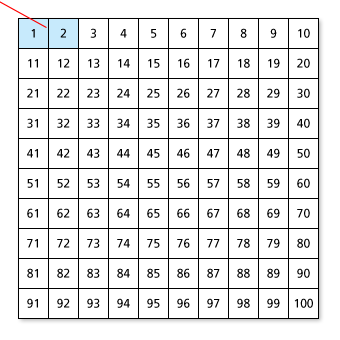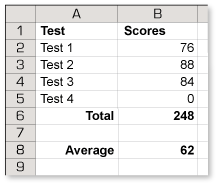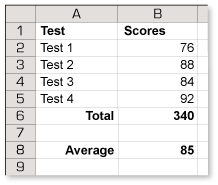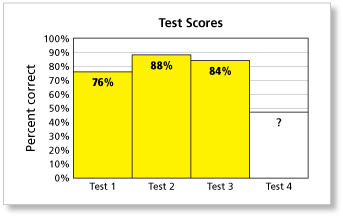-
Decide whether the statement is true or false. Explain your reasoning.
You invest $1250 in the stock market and lose 20% during the first year. To get back to your original investment, your portfolio needs to gain 20% during the second year.
-
When you lose 20% of $1250, you lose


Your investment is now worth only $1000. If you gain 20% during the second year, then you will have gained


This gain will bring you up to $1200, but that does not compensate for your loss.
This statement is false. When you are talking about percent gains and percent losses, be sure you understand what value is being used for the base. If the base is changing, then you are comparing apples to oranges.
Comments (2)These comments are not screened before publication. Constructive debate about the information on this page is welcome, but personal attacks are not. Please do not post comments that are commercial in nature or that violate copyright. Comments that we regard as obscene, defamatory, or intended to incite violence will be removed. If you find a comment offensive, you may flag it.
When posting a comment, you agree to our Terms of Use.Showing 2 commentsSubscribe by email Subscribe by RSSGuest 5 years ago |cặc0 0Guest 5 years ago |cặc0 0 -
-
Decide whether the statement is true or false. Explain your reasoning.
At work, you receive a cost-of-living adjustment (COLA) of 3% each year. Over a 5-year period, your pay will increase by 15%.
These comments are not screened before publication. Constructive debate about the information on this page is welcome, but personal attacks are not. Please do not post comments that are commercial in nature or that violate copyright. Comments that we regard as obscene, defamatory, or intended to incite violence will be removed. If you find a comment offensive, you may flag it.
When posting a comment, you agree to our Terms of Use. -
Decide whether the statement is true or false. Explain your reasoning.
Your property taxes increase by 5% one year and decrease by 1% the next year. Overall, your property taxes are up by 4% over 2 years.
-
This is close to being true, but it isn't quite true for the same reason that the statement in Exercise 25 isn't true. When you are talking about percent increases and percent decreases, be sure you understand what value is being used for the base. If the base is changing, then you are comparing apples to oranges.
For the sake of illustration, suppose your property taxes are $1000. When they increase by 5%, the increase is


Your property taxes are now $1050. If they go down the next year by 1%, the decrease is


This decrease will bring your property taxes down to $1039.50. So, over a 2-year period, you had an increase of $39.50, which is somewhat less than a 4% increase.
These comments are not screened before publication. Constructive debate about the information on this page is welcome, but personal attacks are not. Please do not post comments that are commercial in nature or that violate copyright. Comments that we regard as obscene, defamatory, or intended to incite violence will be removed. If you find a comment offensive, you may flag it.
When posting a comment, you agree to our Terms of Use. -
-
Decide whether the statement is true or false. Explain your reasoning.
Everything in a store is on sale for 40% off. You have a coupon for 10% off the purchase price. When you go to the counter to pay, you will receive 50% off the original price.
These comments are not screened before publication. Constructive debate about the information on this page is welcome, but personal attacks are not. Please do not post comments that are commercial in nature or that violate copyright. Comments that we regard as obscene, defamatory, or intended to incite violence will be removed. If you find a comment offensive, you may flag it.
When posting a comment, you agree to our Terms of Use. -
You open a savings account that has a 2.0% simple annual interest rate. At the end of the first year, you have earned $30 in interest. No other transactions were posted to the account. What is the balance of the account at the end of the first year?
-
This problem is more difficult than it first appears.

To find the deposit, imagine that of 100 parts, 2 parts equals $30.
This means that 4 parts equals $60, 10 parts equals $150, and 20 parts equals $300.
Following this pattern, you can conclude that 100 parts equals $1500.
You can check this by multiplying.


So, your balance at the end of the first year is

These comments are not screened before publication. Constructive debate about the information on this page is welcome, but personal attacks are not. Please do not post comments that are commercial in nature or that violate copyright. Comments that we regard as obscene, defamatory, or intended to incite violence will be removed. If you find a comment offensive, you may flag it.
When posting a comment, you agree to our Terms of Use. -
-
As part of a political platform, a politician promises to cut spending by 110%. Is this possible? Explain your reasoning.
These comments are not screened before publication. Constructive debate about the information on this page is welcome, but personal attacks are not. Please do not post comments that are commercial in nature or that violate copyright. Comments that we regard as obscene, defamatory, or intended to incite violence will be removed. If you find a comment offensive, you may flag it.
When posting a comment, you agree to our Terms of Use. -
Four exams are used to determine your final grade in one of your classes. The bar graph shows the results of the first three exams. What percent do you need on the last exam to receive an 85% in the class?
-
If you know algebra, then you can solve the problem using an equation.

If you don't know algebra, then you can download the spreadsheet and use "trial and error" to find the score you need on the fourth test.

If your 4th score is 0, then your average is 62%.

Keep trying different scores until you find the one that produces an average of 85%.
You need 92% on the 4th test to end up with an average of 85%.
These comments are not screened before publication. Constructive debate about the information on this page is welcome, but personal attacks are not. Please do not post comments that are commercial in nature or that violate copyright. Comments that we regard as obscene, defamatory, or intended to incite violence will be removed. If you find a comment offensive, you may flag it.
When posting a comment, you agree to our Terms of Use. -
-
Your employer currently allocates 5% of the company profits each year to a profit sharing plan for the employees. The board of directors decides to increase the amount allocated by 10%. Does this mean the new policy is to allocate 5.5% or 15% to the profit sharing plan each year? Explain your reasoning.
These comments are not screened before publication. Constructive debate about the information on this page is welcome, but personal attacks are not. Please do not post comments that are commercial in nature or that violate copyright. Comments that we regard as obscene, defamatory, or intended to incite violence will be removed. If you find a comment offensive, you may flag it.
When posting a comment, you agree to our Terms of Use.







